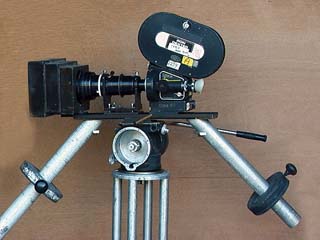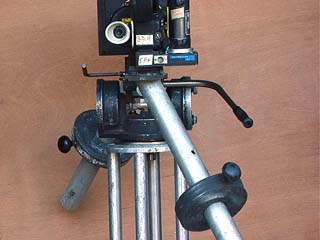Inertial Tripod Head
When a camera car tire goes up over a bump, the camera on a spring balanced
fluid head is tilted forward or backward by the weight of the camera above the
tripod head tilt axis. A nodal or gear head will avoid this motion because there
is no mass above the tilt pivot point and the camera is mounted at it's C. of
G. A very strong nodal head with no flex is necessary. (Large Weaver Steadman)
The Chapman Vibration Isolator removes this motion on dollies, but the motions
on camera cars are usually too extreme.
This solution is a modification of an O'Connor 100B head, one of the strongest
heads ever made. (The O'Connor 150 is stronger.) You carefully remove the tilt
springs by mounting the head on a very strong base and adjusting the "U" bolts
on the camera platform so the platform tilts up or down to allow the springs
to be removed from non-fluid / brake side of the head. BE VERY CAREFUL DOING
THIS! The springs are covered with graphite. Bag and don't clean them. Now you
need to make arms attached to a 2-foot long dovetail or bar at 45 degrees down
and away from the tilt axis. Sliding lead weights are used to balance the head
neutral about the tilt axis center of gravity. If you use 2" IPS aluminum pipe,
you can cast 2" Speed Rail floor flanges in 400' 35 mm film cans of lead. The
floor flanges should be shortened to the depth of the film can. Cast 3/8-16
bolts into the Allen set screw holes in the floor flange for a tightening knob.
Adjust the weights so the head doesn't tip on its own and remains in any position
you leave it in. The rear counter weight can be swung away from the operator's
legs and the front one compensated in the other direction. The rear arm can
be used as a panhandle.

Inertial Head Modification of O'Connor 100 B with Counter Balance Springs
Removed

The brake/spring cover is removed for illustration. Do replace the brake for
use.
If you use muscle-building weights, make sure they are clamped tight with no
play. 1" shaft isn't strong enough for the counterweight arms. You will still
need some sliding trim weights to balance the system perfectly.
An old Mitchell or TV free head can be modified for this inertial method. The
springs have to be removed and a strong head used.
This arrangement is not ergonomic, as it hits the operator's knees if the operator
has his eye up to the eyepiece, but this can be helped with an extension finder
or video finder.
It is also difficult for the operator to keep his eye to the eyepiece with extreme
crane arm moves. A video assist helmet or well-placed video finder will help
the operator operate in a more comfortable position. Good light shielding is
necessary for the remote video finder. Dark clothes on the operator will help
reduce light spilling on the video screen.
One problem with video finders is the lower resolution. You can see detail on
the ground glasses that is not seen on video. Here is where watching with both
eyes open can be a useful skill. Developing this skill takes much practice,
but is one of the most valuable for an operator who uses remote finders, especially
head mounted ones.
A video monitor for the camera car driver is also very helpful, especially when
refining a move.
© Copyright 1999-2004 Ron Dexter. All Rights Reserved.



